trailer LINCOLN MKS 2016 Owners Manual
[x] Cancel search | Manufacturer: LINCOLN, Model Year: 2016, Model line: MKS, Model: LINCOLN MKS 2016Pages: 382, PDF Size: 3.81 MB
Page 6 of 382
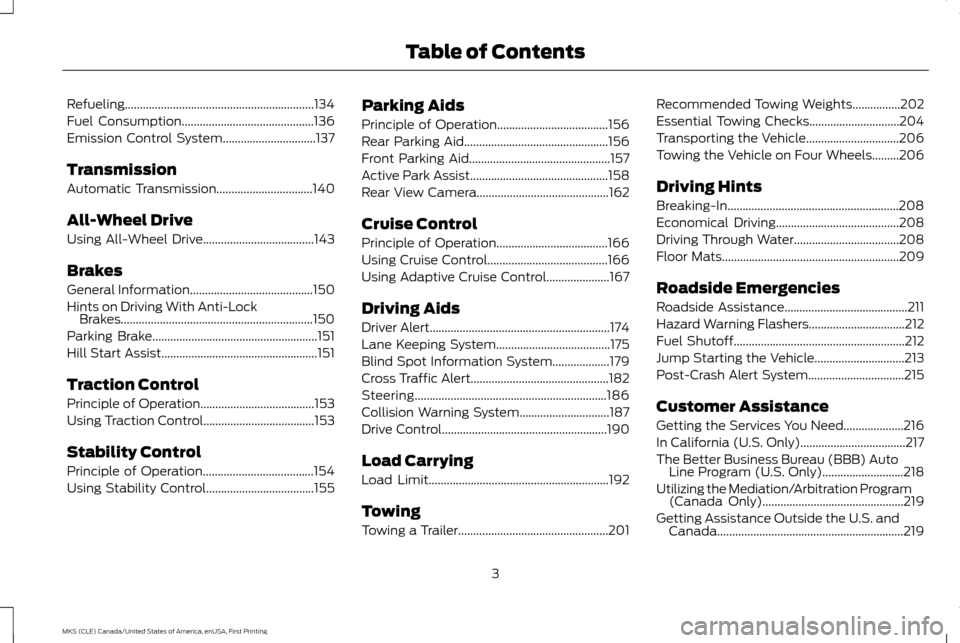
Refueling...............................................................134
Fuel Consumption............................................136
Emission Control System...............................137
Transmission
Automatic Transmission
................................140
All-Wheel Drive
Using All-Wheel Drive.....................................143
Brakes
General Information
.........................................150
Hints on Driving With Anti-Lock Brakes................................................................150
Parking Brake
.......................................................151
Hill Start Assist
....................................................151
Traction Control
Principle of Operation......................................153
Using Traction Control
.....................................153
Stability Control
Principle of Operation.....................................154
Using Stability Control....................................155 Parking Aids
Principle of Operation.....................................156
Rear Parking Aid................................................156
Front Parking Aid
...............................................157
Active Park Assist..............................................158
Rear View Camera
............................................162
Cruise Control
Principle of Operation
.....................................166
Using Cruise Control........................................166
Using Adaptive Cruise Control.....................167
Driving Aids
Driver Alert
............................................................174
Lane Keeping System......................................175
Blind Spot Information System
...................179
Cross Traffic Alert..............................................182
Steering................................................................186
Collision Warning System..............................187
Drive Control
.......................................................190
Load Carrying
Load Limit............................................................192
Towing
Towing a Trailer
..................................................201 Recommended Towing Weights................202
Essential Towing Checks..............................204
Transporting the Vehicle...............................206
Towing the Vehicle on Four Wheels.........206
Driving Hints
Breaking-In.........................................................208
Economical Driving
.........................................208
Driving Through Water...................................208
Floor Mats
...........................................................209
Roadside Emergencies
Roadside Assistance
.........................................211
Hazard Warning Flashers................................212
Fuel Shutoff
.........................................................212
Jump Starting the Vehicle..............................213
Post-Crash Alert System................................215
Customer Assistance
Getting the Services You Need....................216
In California (U.S. Only)...................................217
The Better Business Bureau (BBB) Auto Line Program (U.S. Only)...........................218
Utilizing the Mediation/Arbitration Program (Canada Only)
...............................................219
Getting Assistance Outside the U.S. and Canada..............................................................219
3
MKS (CLE) Canada/United States of America, enUSA, First Printing Table of Contents
Page 136 of 382
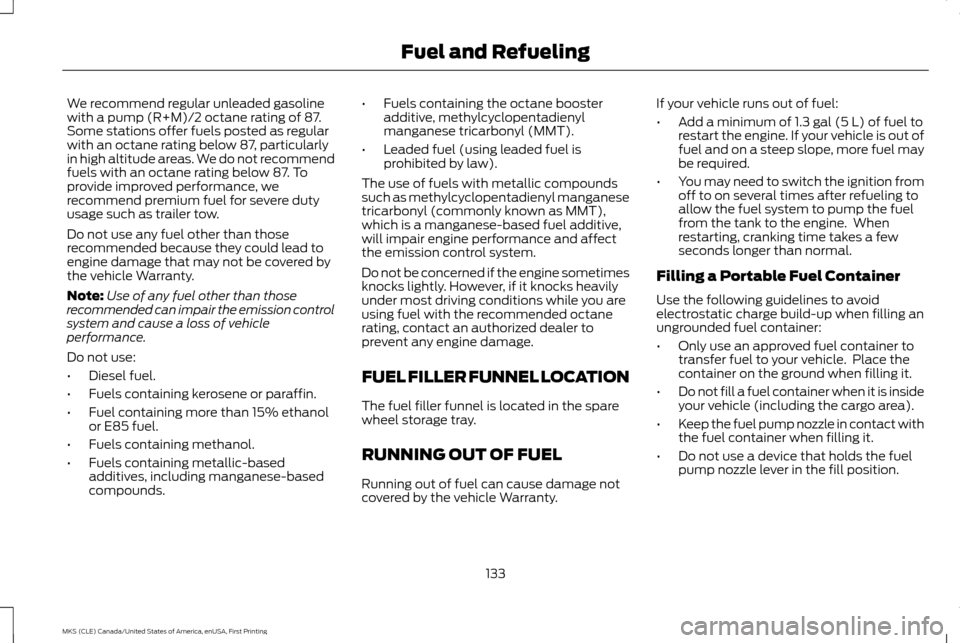
We recommend regular unleaded gasoline
with a pump (R+M)/2 octane rating of 87.
Some stations offer fuels posted as regular
with an octane rating below 87, particularly
in high altitude areas. We do not recommend
fuels with an octane rating below 87. To
provide improved performance, we
recommend premium fuel for severe duty
usage such as trailer tow.
Do not use any fuel other than those
recommended because they could lead to
engine damage that may not be covered by
the vehicle Warranty.
Note:
Use of any fuel other than those
recommended can impair the emission control
system and cause a loss of vehicle
performance.
Do not use:
• Diesel fuel.
• Fuels containing kerosene or paraffin.
• Fuel containing more than 15% ethanol
or E85 fuel.
• Fuels containing methanol.
• Fuels containing metallic-based
additives, including manganese-based
compounds. •
Fuels containing the octane booster
additive, methylcyclopentadienyl
manganese tricarbonyl (MMT).
• Leaded fuel (using leaded fuel is
prohibited by law).
The use of fuels with metallic compounds
such as methylcyclopentadienyl manganese
tricarbonyl (commonly known as MMT),
which is a manganese-based fuel additive,
will impair engine performance and affect
the emission control system.
Do not be concerned if the engine sometimes
knocks lightly. However, if it knocks heavily
under most driving conditions while you are
using fuel with the recommended octane
rating, contact an authorized dealer to
prevent any engine damage.
FUEL FILLER FUNNEL LOCATION
The fuel filler funnel is located in the spare
wheel storage tray.
RUNNING OUT OF FUEL
Running out of fuel can cause damage not
covered by the vehicle Warranty. If your vehicle runs out of fuel:
•
Add a minimum of 1.3 gal (5 L) of fuel to
restart the engine. If your vehicle is out of
fuel and on a steep slope, more fuel may
be required.
• You may need to switch the ignition from
off to on several times after refueling to
allow the fuel system to pump the fuel
from the tank to the engine. When
restarting, cranking time takes a few
seconds longer than normal.
Filling a Portable Fuel Container
Use the following guidelines to avoid
electrostatic charge build-up when filling an
ungrounded fuel container:
• Only use an approved fuel container to
transfer fuel to your vehicle. Place the
container on the ground when filling it.
• Do not fill a fuel container when it is inside
your vehicle (including the cargo area).
• Keep the fuel pump nozzle in contact with
the fuel container when filling it.
• Do not use a device that holds the fuel
pump nozzle lever in the fill position.
133
MKS (CLE) Canada/United States of America, enUSA, First Printing Fuel and Refueling
Page 159 of 382
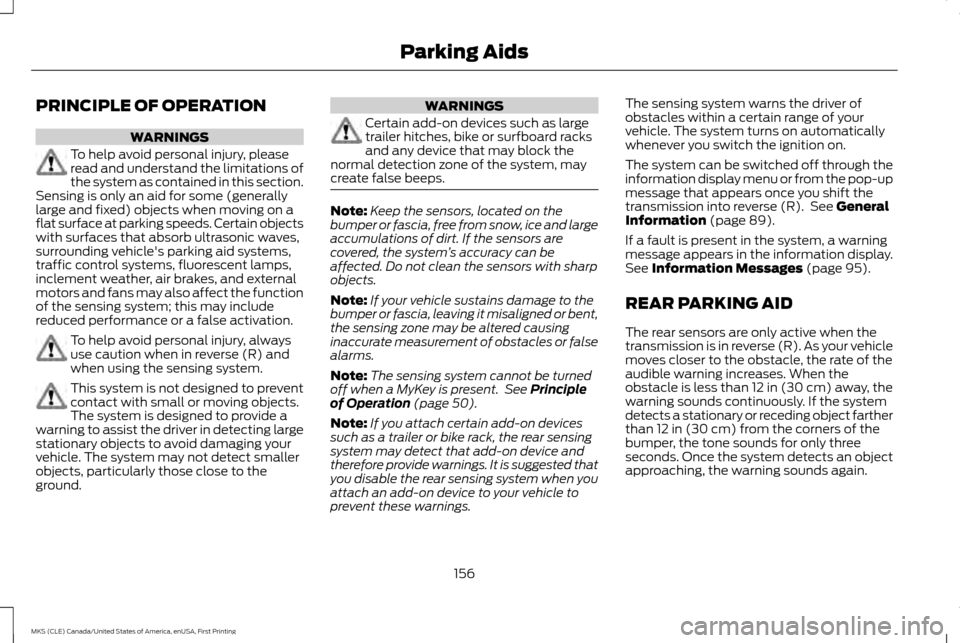
PRINCIPLE OF OPERATION
WARNINGS
To help avoid personal injury, please
read and understand the limitations of
the system as contained in this section.
Sensing is only an aid for some (generally
large and fixed) objects when moving on a
flat surface at parking speeds. Certain objects
with surfaces that absorb ultrasonic waves,
surrounding vehicle's parking aid systems,
traffic control systems, fluorescent lamps,
inclement weather, air brakes, and external
motors and fans may also affect the function
of the sensing system; this may include
reduced performance or a false activation. To help avoid personal injury, always
use caution when in reverse (R) and
when using the sensing system.
This system is not designed to prevent
contact with small or moving objects.
The system is designed to provide a
warning to assist the driver in detecting large
stationary objects to avoid damaging your
vehicle. The system may not detect smaller
objects, particularly those close to the
ground. WARNINGS
Certain add-on devices such as large
trailer hitches, bike or surfboard racks
and any device that may block the
normal detection zone of the system, may
create false beeps. Note:
Keep the sensors, located on the
bumper or fascia, free from snow, ice and large
accumulations of dirt. If the sensors are
covered, the system ’s accuracy can be
affected. Do not clean the sensors with sharp
objects.
Note: If your vehicle sustains damage to the
bumper or fascia, leaving it misaligned or bent,
the sensing zone may be altered causing
inaccurate measurement of obstacles or false
alarms.
Note: The sensing system cannot be turned
off when a MyKey is present. See Principle
of Operation (page 50).
Note: If you attach certain add-on devices
such as a trailer or bike rack, the rear sensing
system may detect that add-on device and
therefore provide warnings. It is suggested that
you disable the rear sensing system when you
attach an add-on device to your vehicle to
prevent these warnings. The sensing system warns the driver of
obstacles within a certain range of your
vehicle. The system turns on automatically
whenever you switch the ignition on.
The system can be switched off through the
information display menu or from the pop-up
message that appears once you shift the
transmission into reverse (R). See
General
Information (page 89).
If a fault is present in the system, a warning
message appears in the information display.
See
Information Messages (page 95).
REAR PARKING AID
The rear sensors are only active when the
transmission is in reverse (R). As your vehicle
moves closer to the obstacle, the rate of the
audible warning increases. When the
obstacle is less than
12 in (30 cm) away, the
warning sounds continuously. If the system
detects a stationary or receding object farther
than
12 in (30 cm) from the corners of the
bumper, the tone sounds for only three
seconds. Once the system detects an object
approaching, the warning sounds again.
156
MKS (CLE) Canada/United States of America, enUSA, First Printing Parking Aids
Page 161 of 382

If the transmission is in drive (D) or any other
forward gear (for example, low (L), sport (S)
or any forward gear in a manual
transmission), the front sensing system
provides audio warnings when your vehicle
is moving below a speed of 7 mph (12 km/h)
and an obstacle is located inside the
detection area.
ACTIVE PARK ASSIST (If Equipped)
WARNINGS
Designed to be a supplementary park
aid, this system may not work in all
conditions. This system cannot replace
the driver ’s attention and judgment. The
driver is responsible for avoiding hazards and
maintaining a safe distance and speed, even
when the system is in use. Active Park Assist does not apply the
brakes under any circumstances.
Note:
The driver is always responsible for
controlling the vehicle, supervising the system
and intervening if required by grabbing the
steering wheel or pressing the active park
assist button (if equipped). Note:
The sensors may not detect objects in
heavy rain, snow or other conditions that cause
disruptive reflections.
Note: Keep the sensors, located on the
bumper or fascia, free from snow, ice and large
accumulations of dirt. Covered sensors can
affect the system's accuracy. Do not clean the
sensors with sharp objects.
Note: The sensors may not detect objects
with surfaces that absorb ultrasonic waves.
Active Park Assist is an electric parking aid
that uses ultrasonic sensors. The system
detects an available parallel parking space
and automatically steers your vehicle into
the space (hands-free) while you control the
accelerator, gearshift and brakes. The system
visually and audibly instructs you to park your
vehicle.
The system may not function correctly if
something passes between the front bumper
and the parking space (a pedestrian or
cyclist) or if the edge of the neighboring
parked vehicle is high off the ground (for
example, a bus, tow truck or flatbed truck).
If you are uncomfortable with the proximity
to any vehicle or object, you may choose to
override the system. The system may not operate correctly in any
of the following conditions:
•
You use a spare tire or a tire significantly
worn more than the other tires.
• One or more tires are improperly inflated.
• You try to park on a tight curve.
Do not use the system if:
• You have attached a bike rack, trailer or
similar object to the front or rear of your
vehicle, close to the sensors.
• You have attached an overhanging object
(surfboard) to the roof.
• The front bumper or side sensors are
damaged or obstructed (front bumper
cover).
• The correct tire size is not in use on your
vehicle (for example, a mini-spare tire).
Using Active Park Assist Press the button to turn the system
on or off.
158
MKS (CLE) Canada/United States of America, enUSA, First Printing Parking AidsE144525
Page 166 of 382
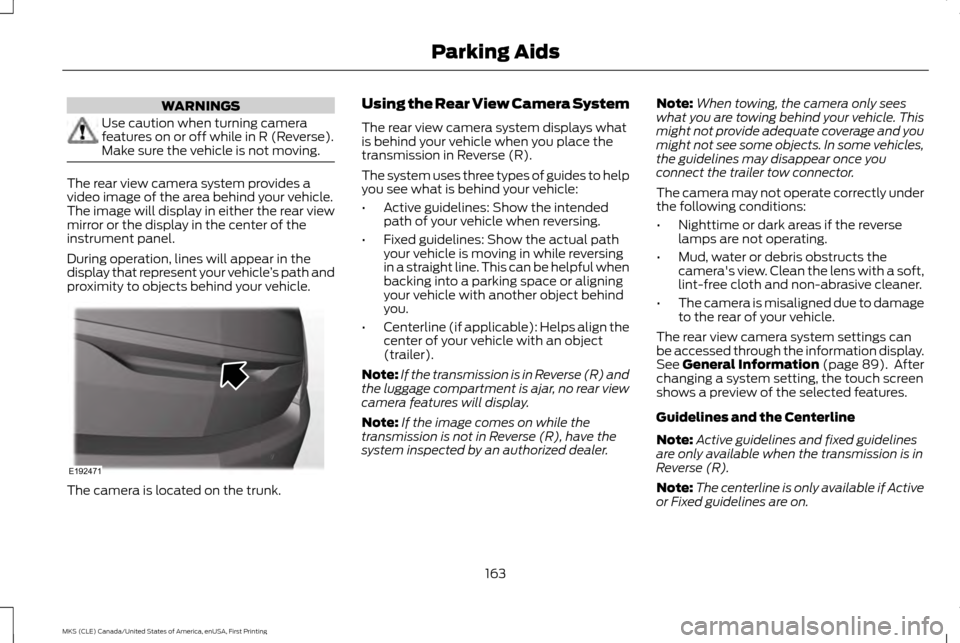
WARNINGS
Use caution when turning camera
features on or off while in R (Reverse).
Make sure the vehicle is not moving.
The rear view camera system provides a
video image of the area behind your vehicle.
The image will display in either the rear view
mirror or the display in the center of the
instrument panel.
During operation, lines will appear in the
display that represent your vehicle
’s path and
proximity to objects behind your vehicle. The camera is located on the trunk. Using the Rear View Camera System
The rear view camera system displays what
is behind your vehicle when you place the
transmission in Reverse (R).
The system uses three types of guides to help
you see what is behind your vehicle:
•
Active guidelines: Show the intended
path of your vehicle when reversing.
• Fixed guidelines: Show the actual path
your vehicle is moving in while reversing
in a straight line. This can be helpful when
backing into a parking space or aligning
your vehicle with another object behind
you.
• Centerline (if applicable): Helps align the
center of your vehicle with an object
(trailer).
Note: If the transmission is in Reverse (R) and
the luggage compartment is ajar, no rear view
camera features will display.
Note: If the image comes on while the
transmission is not in Reverse (R), have the
system inspected by an authorized dealer. Note:
When towing, the camera only sees
what you are towing behind your vehicle. This
might not provide adequate coverage and you
might not see some objects. In some vehicles,
the guidelines may disappear once you
connect the trailer tow connector.
The camera may not operate correctly under
the following conditions:
• Nighttime or dark areas if the reverse
lamps are not operating.
• Mud, water or debris obstructs the
camera's view. Clean the lens with a soft,
lint-free cloth and non-abrasive cleaner.
• The camera is misaligned due to damage
to the rear of your vehicle.
The rear view camera system settings can
be accessed through the information display.
See General Information (page 89). After
changing a system setting, the touch screen
shows a preview of the selected features.
Guidelines and the Centerline
Note: Active guidelines and fixed guidelines
are only available when the transmission is in
Reverse (R).
Note: The centerline is only available if Active
or Fixed guidelines are on.
163
MKS (CLE) Canada/United States of America, enUSA, First Printing Parking AidsE192471
Page 170 of 382

Switching Cruise Control Off
Press and release OFF when the system is
in stand by mode or switch the ignition off.
Note: You erase the set speed when you
switch the system off.
USING ADAPTIVE CRUISE
CONTROL
(If Equipped) WARNINGS
Always pay close attention to changing
road conditions when using adaptive
cruise control. The system does not
replace attentive driving. Failing to pay
attention to the road may result in a crash,
serious injury or death. Adaptive cruise control is not a crash
warning or avoidance system.
Adaptive cruise control will not detect
stationary or slow moving vehicles
below 6 mph (10 km/h).
Adaptive cruise control does not detect
pedestrians or objects in the road.
Adaptive cruise control does not detect
oncoming vehicles in the same lane. WARNINGS
Do not use the adaptive cruise control
when entering or leaving a highway, in
heavy traffic or on roads that are
winding, slippery or unpaved. Do not use the system in poor visibility,
for example fog, heavy rain, spray or
snow.
Do not use adaptive cruise control
when towing a trailer that has trailer
brakes. The auto-brake component of
the adaptive cruise control system does not
operate the trailer brakes. Using adaptive
cruise control when towing a trailer that has
trailer brakes may result in the loss of vehicle
control, which could result in serious injury. Do not use tire sizes other than those
recommended because this can affect
the normal operation of the system.
Failing to do so may result in a loss of vehicle
control, which could result in serious injury. Note:
It is your responsibility to stay alert, drive
safely and be in control of the vehicle at all
times.
The system adjusts your speed to maintain
a proper distance between you and the
vehicle in front of you in the same lane. You
can select from one of four gap settings. The adaptive cruise controls are on the
steering wheel.
Setting Adaptive Cruise Control
Press and release
ON.
The indicator appears in the
instrument cluster.
167
MKS (CLE) Canada/United States of America, enUSA, First Printing Cruise ControlE173593 E144529 E173594
Page 182 of 382

Why does the vehicle not come back into the middle of the lane always, as expected, in the Aid or Aid + Alert mode?
High cross winds
Large road crown
Rough roads, grooves, shoulder drop-offs
Heavy uneven loading of the vehicle or improper tire inflation pressure
If the tires have been exchanged (including snow tires), or the suspension has been modified
Vehicle accessories such as snow plows or trailers
BLIND SPOT INFORMATION
SYSTEM WARNING
To help avoid injuries, NEVER use the
Blind Spot Information System as a
replacement for using the interior and
exterior mirrors or looking over your shoulder
before changing lanes. The Blind Spot
Information System is not a replacement for
careful driving. The Blind Spot Information System is
designed to aid you in detecting vehicles that
may have entered the blind spot zone (A).
The detection area is on both sides of your
vehicle, extending rearward from the exterior
mirrors to approximately 13 ft (4 m) beyond
the bumper. The system is designed to alert
you if certain vehicles enter the blind spot
zone while driving.
Note: The Blind Spot Information System
does not prevent contact with other vehicles
or objects; nor detect parked vehicles, people,
animals or infrastructure (fences, guardrails,
trees). It’ s only designed to alert you to
vehicles in the blind spot zones.
179
MKS (CLE) Canada/United States of America, enUSA, First Printing Driving AidsA
A
E124788
Page 184 of 382
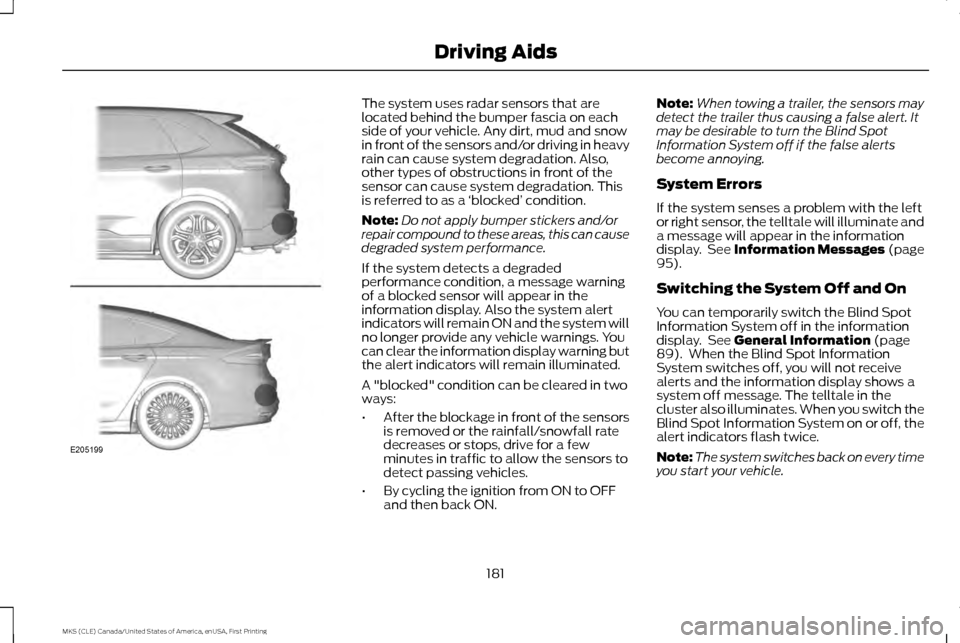
The system uses radar sensors that are
located behind the bumper fascia on each
side of your vehicle. Any dirt, mud and snow
in front of the sensors and/or driving in heavy
rain can cause system degradation. Also,
other types of obstructions in front of the
sensor can cause system degradation. This
is referred to as a
‘blocked ’ condition.
Note: Do not apply bumper stickers and/or
repair compound to these areas, this can cause
degraded system performance.
If the system detects a degraded
performance condition, a message warning
of a blocked sensor will appear in the
information display. Also the system alert
indicators will remain ON and the system will
no longer provide any vehicle warnings. You
can clear the information display warning but
the alert indicators will remain illuminated.
A "blocked" condition can be cleared in two
ways:
• After the blockage in front of the sensors
is removed or the rainfall/snowfall rate
decreases or stops, drive for a few
minutes in traffic to allow the sensors to
detect passing vehicles.
• By cycling the ignition from ON to OFF
and then back ON. Note:
When towing a trailer, the sensors may
detect the trailer thus causing a false alert. It
may be desirable to turn the Blind Spot
Information System off if the false alerts
become annoying.
System Errors
If the system senses a problem with the left
or right sensor, the telltale will illuminate and
a message will appear in the information
display. See Information Messages (page
95).
Switching the System Off and On
You can temporarily switch the Blind Spot
Information System off in the information
display. See
General Information (page
89). When the Blind Spot Information
System switches off, you will not receive
alerts and the information display shows a
system off message. The telltale in the
cluster also illuminates. When you switch the
Blind Spot Information System on or off, the
alert indicators flash twice.
Note: The system switches back on every time
you start your vehicle.
181
MKS (CLE) Canada/United States of America, enUSA, First Printing Driving AidsE205199
Page 189 of 382
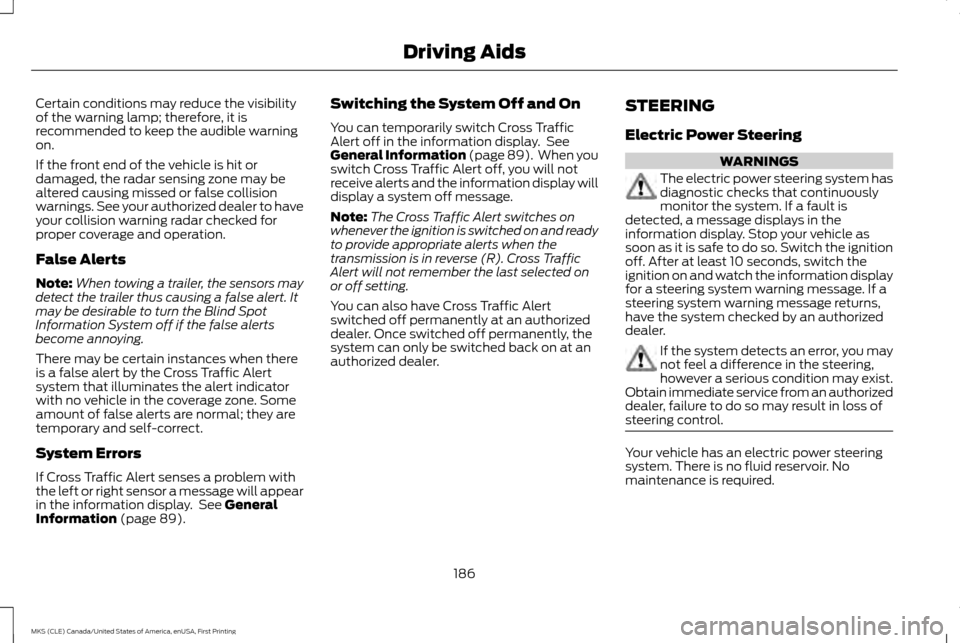
Certain conditions may reduce the visibility
of the warning lamp; therefore, it is
recommended to keep the audible warning
on.
If the front end of the vehicle is hit or
damaged, the radar sensing zone may be
altered causing missed or false collision
warnings. See your authorized dealer to have
your collision warning radar checked for
proper coverage and operation.
False Alerts
Note:
When towing a trailer, the sensors may
detect the trailer thus causing a false alert. It
may be desirable to turn the Blind Spot
Information System off if the false alerts
become annoying.
There may be certain instances when there
is a false alert by the Cross Traffic Alert
system that illuminates the alert indicator
with no vehicle in the coverage zone. Some
amount of false alerts are normal; they are
temporary and self-correct.
System Errors
If Cross Traffic Alert senses a problem with
the left or right sensor a message will appear
in the information display. See General
Information (page 89). Switching the System Off and On
You can temporarily switch Cross Traffic
Alert off in the information display. See
General Information
(page 89). When you
switch Cross Traffic Alert off, you will not
receive alerts and the information display will
display a system off message.
Note: The Cross Traffic Alert switches on
whenever the ignition is switched on and ready
to provide appropriate alerts when the
transmission is in reverse (R). Cross Traffic
Alert will not remember the last selected on
or off setting.
You can also have Cross Traffic Alert
switched off permanently at an authorized
dealer. Once switched off permanently, the
system can only be switched back on at an
authorized dealer. STEERING
Electric Power Steering WARNINGS
The electric power steering system has
diagnostic checks that continuously
monitor the system. If a fault is
detected, a message displays in the
information display. Stop your vehicle as
soon as it is safe to do so. Switch the ignition
off. After at least 10 seconds, switch the
ignition on and watch the information display
for a steering system warning message. If a
steering system warning message returns,
have the system checked by an authorized
dealer. If the system detects an error, you may
not feel a difference in the steering,
however a serious condition may exist.
Obtain immediate service from an authorized
dealer, failure to do so may result in loss of
steering control. Your vehicle has an electric power steering
system. There is no fluid reservoir. No
maintenance is required.
186
MKS (CLE) Canada/United States of America, enUSA, First Printing Driving Aids
Page 195 of 382

LOAD LIMIT
Vehicle Loading - with and
without a Trailer
This section will guide you in the
proper loading of your vehicle, trailer
or both, to keep your loaded vehicle
weight within its design rating
capability, with or without a trailer.
Properly loading your vehicle will
provide maximum return of vehicle
design performance. Before loading
your vehicle, familiarize yourself with
the following terms for determining
your vehicle
’s weight ratings, with
or without a trailer, from the
vehicle ’s Tire Label or Safety
Compliance Certification Label: Base Curb Weight - is the weight
of the vehicle including full fluids
and all standard equipment. It does
not include passengers, cargo, or
optional equipment.
Vehicle Curb Weight -
is the
weight of your new vehicle when you
picked it up from your authorized
dealer plus any aftermarket
equipment. Payload -
is the combined weight
of cargo and passengers that the
vehicle is carrying. The maximum
payload for your vehicle can be
found on the Tire Label on the
B-Pillar or the edge of the driver door (vehicles exported outside the
US and Canada may not have a Tire
Label). Look for
“THE COMBINED
WEIGHT OF OCCUPANTS AND
CARGO SHOULD NEVER EXCEED
XXX kg OR XXX lb. ” for maximum
192
MKS (CLE) Canada/United States of America, enUSA, First Printing Load CarryingE143816PAYLOAD